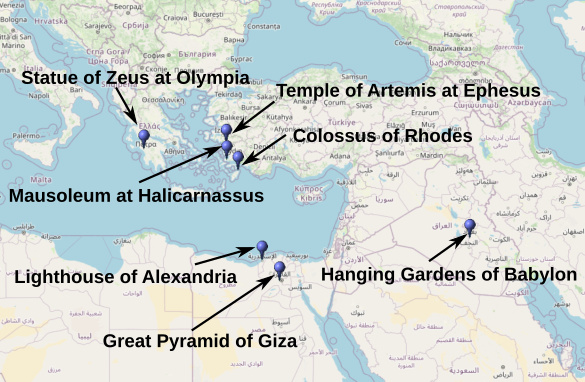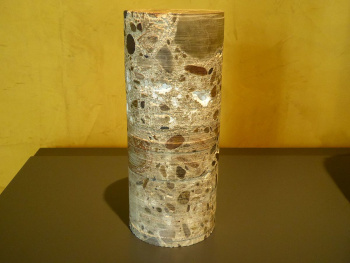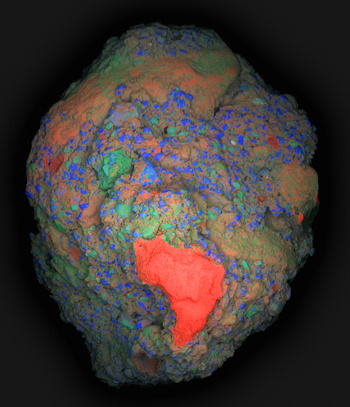Roman Concrete
February 20, 2023
As any
homeowner knows, a
house will fall into
ruin without continual
maintenance. As they say,
a stitch in time saves nine; so, that small
water leak under the
kitchen sink can lead to a
water damaged floor if not
repaired quickly enough. A well maintained house might have a
lifespan of a
century or two, and few structures will persist over
millennia. Only one of the
Seven Wonders of the Ancient World still exists. The remaining six were destroyed by such things as
fire and
earthquakes.

map of the Seven Wonders of the Ancient World. Despite its description and pictorial depiction in one of my childhood Golden Books, there's reason to believe that one of these, the Hanging Gardens of Babylon, did not really exist. (Map via the OpenStreetMap Foundation, released under the Open Data Commons Open Database License, and modified using Inkscape. Click for larger image.)
The
permanence of the
modern world is a consequence of the use of
concrete as a
building material. Water is the most used substance in our modern world, but concrete is the second. Concrete is formed as a
mixture of
cement and various
aggregates, such as
sand,
gravel, and
crushed stone. Sand is a preferred aggregate, since its small size leads to lesser need for the more
costly cement. As I wrote in a
previous article (Sand, October 18, 2021), concrete can't be made from
desert sand, since the
grains are too
smooth. The following table shows the tremendous quantities of cement manufactured in a single
year.[1-2]
Portland and Masonry Cement (2021)
| Country |
Thousand
Metric Tons |
Country |
Thousand
Metric Tonss |
| United States |
92,000 |
Brazil |
65,000 |
| China |
2,500,000 |
Egypt |
40,000 |
| India |
330,000 |
Indonesia |
66,000 |
| Iran |
62,000 |
Japan |
52,000 |
| South Korea |
48,000 |
Mexico |
50,000 |
| Russia |
56,000 |
Saudi Arabia |
55,000 |
| Turkey |
776,000 |
Vietnam |
100,000 |
| Other countries |
810,000 |
World total |
4,400,000 |
As can be seen from the table, China's need for cement is much larger than that for other countries; and, all that cement needs a like quantity of sand to make concrete. China had
dredged large quantities of sand from the
bed and
shores of
Poyang Lake in the Chinese
province of
Jiangxi, causing an
environmental disaster. Now, Chinese dredgers have been taking sand in the
territorial waters of
Taiwan,
Japan, and other countries.
Concrete has been used for more than three millennia. The
royal palace of
Tiryns,
Greece, which dates to around 1300 BC, had concrete
floors.[3]
Roman concrete, which was in common use from about 150 BC and possibly used a
century earlier, has been of special interest to
materials scientists because of its
durability and persistence to the present day. It's been written that "Roman-era concrete is the
iconic embodiment of long-term
physicochemical resilience."[4] There's even a
website dedicated to Roman concrete.[5]
Roman concrete is durable possibly from the incorporation of
volcanic ash, known as
pozzolanic ash (pulvis puteolanus), that prevents
crack propagation. As
Vitruvius (80-70 BC - post 15 BC), who famously stated that
architects deserve more
honor than
wrestlers, wrote in Book II, Chapter 6, of his
treatise,
De Architectura (On Architecture),[6]
Est etiam genus pulveris, quod efficit naturaliter res admirandas. nascitur in regionibus Baianis in agris municipiorum, quae sunt circa Vesuvium montem. quod commixtum cum calce et caemento non modo ceteris aedificiis praestat firmitates, sed etiam moles cum struuntur in mari, sub aqua solidescunt. hoc autem fieri hac ratione videtur, quod sub his montibus et terrae ferventes sunt et fontes crebri, qui non essent, si non in imo haberent aut e sulphure aut alumine aut bitumine ardentes maximos ignes. igitur penitus ignis et flammae vapor per intervenia permanans et ardens efficit levem eam terram, et ibi quod nascitur tofus exsurgens, est sine liquore. ergo cum tres res consimili ratione ignis vehementia foratae in unam pervenerint mixtionem, repente recepto liquore una cohaerescunt et celeriter umore duratae solidantur, neque eas fluctus neque vis aquae potest dissolvere.
There is a species of sand which, naturally, possesses extraordinary qualities. It is found about Baiae and the territory in the neighbourhood of Mount Vesuvius; if mixed with lime and rubble, it hardens as well under water as in ordinary buildings. This seems to arise from the hotness of the earth under these mountains, and the abundance of springs under their bases, which are heated either with sulphur, bitumen, or alum, and indicate very intense fire. The inward fire and heat of the flame which escapes and burns through the chinks, makes this earth light; the sand-stone (tophus), therefore, which is gathered in the neighbourhood, is dry and free from moisture. Since, then, three circumstances of a similar nature, arising from the intensity of the fire, combine in one mixture, as soon as moisture supervenes, they cohere and quickly harden through dampness; so that neither the waves nor the force of the water can disunite them.
The pozzolanic ash is an
aluminosilicate which reacts at
room temperature with
calcium hydroxide (Ca(OH)
2) and water. This reaction creates a cement of insoluble
calcium silicate hydrate and
calcium aluminate hydrate compounds. The reaction of
calcium silicate (Ca3SiO5) and water to produce calcium silicate hydrate (CaO.2SiO
2.4H
2O) and calcium hydroxide is as follows:
2Ca3SiO5 + 7H2O -> 3CaO·2SiO2·4H2O + 3Ca(OH)2

Core sample of Roman concrete from the Roman Theater of Augustus Caesar.
As can be seen from the core sample, the aggregates were typically far larger than those in modern concrete.
The Pantheon dome, the world's largest and oldest unreinforced concrete dome, is made from Roman concrete.
Unlike modern concrete, which achieves its highest strength within days, The strength of Roman concrete increases over several decades.
(Wikimedia Commons image by Millars.)
Binding additives to Roman concrete included
quicklime (calcium oxide, CaO) and
gypsum (Calcium sulfate, CaSO4). Examination of Roman concrete specimens revealed the existence of lime
clasts; that is, chunks of poorly mixed quicklime, which were just thought to be an indication of of poor aggregation
technique with no real consequence. However, a recent
open access article in
Science Advances indicates that this was a purposeful addition for added strength.[7-8]
The
research team included members from the
Massachusetts Institute of Technology (Cambridge, Massachusetts),
Harvard University (Cambridge, Massachusetts), the
Istituto Meccanica dei Materiali SA (Grancia, Switzerland), and
DMAT (Udine, Italy).[7]
The special durability of Roman concrete under harsh conditions, such as earthquakes, and its use as a
material for
aqueducts and
seawalls, has been a
mystery even under modern
scientific inquiry.[8] Its volcanic ash component from Pozzuoli, on the
Gulf of Naples, had always seemed to be the singular determinant of its strength.[8] However, large, aggregate-scale lumps of raw lime, known as lime clasts, are also a
ubiquitous and
conspicuous feature of the material.[7] The presence of these lime clasts, which are not present in modern concrete, have been attributed to some possible causes, such as improper
calcining of lime and insufficient mixing of the
mortar.[7-8] This new study suggests that these lime clasts give Roman concrete a
self-healing capability.[8]
It had been assumed that the lime incorporated into Roman concrete was first combined with water, in a process called
slaking, to form a highly
reactive paste-like calcium hydroxide (CaOH) from the quicklime calcium oxide.[8] However, slaked lime would not produce lime clasts; so, it appeared that Roman concrete was made using quicklime.[8]
Spectroscopic examination indicated exposure to high temperature, something expected from the
exothermic reaction involving quicklime.[7-8] Such hot-mixing contributed to the durability of Roman concrete.[7-8] This increased temperature significantly reduces setting times, and this would allow for faster construction.[8]

A large-area elemental map of a two centimeter fragment of ancient Roman concrete collected from the archaeological site of Privernum, Italy.
The color coding is calcium = red, silicon = blue, and aluminum = green).
A calcium-rich lime clast (red), is clearly visible in the lower region of the elemental map.
(Portion of an MIT image courtesy of the Roman concrete research team.)
The crack self-healing mechanism is based on the high
surface area lime clasts that act as a source of reactive calcium.[7] The high surface area arise from the
brittle nature of the lime inclusions that cause them to fracture into nanoparticules.[8] To verify this behavior, the researchers prepared their own cement mixture with the hot mixing method, and they found that cracks measuring up to 0.5
millimeter in
width would self-heal.[7] The lime, reacting with water, creates a
saturated solution of calcium that
recrystallizes as
calcium carbonate (CaCO3) to both fill cracks, or react with the volcanic ash.[8] In the
experiments, cracks healed within two
weeks in the simulated Roman concrete, but not in modern concrete.[8] The research team is working to
commercialize their modified cement material, which might be useful in the
3D-printing of concrete.[8]
References:
- Cement Statistics and Information, National Minerals Information Center, U.S. Department of the Interior.
- Mineral Commodity Summaries, Cement Statistics and Information 2022, United States Geological Survey.
- Amelia Carolina Sparavigna, "Ancient concrete works," arXiv, October 24, 2011.
- Jackson MacFarlane, Tiziana Vanorio, and Paulo J.M. Monteiro, "The Importance of the Ultra-alkaline Volcanic Nature of the Raw Materials to the Ductility of Roman Marine Concrete," arXiv, January 29, 2020
- David Moore, "The Roman Pantheon: The Triumph of Concrete," romanconcrete.com.
- Vitruvius Pollio, "De Architectura," F. Krohn, Lipsiae. B.G. Teubner. 1912 (via Tufts University Project Perseus). English translation, The Architecture of Marcus Vitruvius Pollio, translated by Joseph Gwilt, London: Priestley and Weale, 1826 (via the University of Chicago).
- Linda M. Seymour, Janille Maragh, Paolo Sabatini, Michel Di Tommaso, James C. Weaver, and Admir Masic, "Hot mixing: Mechanistic insights into the durability of ancient Roman concrete," Science Advances, vol. 9, no. 1 (January 6, 2023). This is an open access paper with a PDF file here.
- David L. Chandler, "Riddle solved: Why was Roman concrete so durable?" MIT Press Release, January 6, 2023.
Linked Keywords: Owner-occupier; homeowner; house; ruin; maintenance (technical); a stitch in time saves nine<; water leak; kitchen; sink; water damage; floor; service life; lifespan; century; millennia; Seven Wonders of the Ancient World; fire; earthquake; Great Pyramid of Giza; Hanging Gardens of Babylon; Statue of Zeus at Olympia; Temple of Artemis at Ephesus; Mausoleum at Halicarnassus; Colossus of Rhodes; Lighthouse of Alexandria; map; image; pictorial depiction; childhood; Western Publishing 1950s; Golden Books; OpenStreetMap Foundation; Open Data Commons Open Database License; Inkscape; permanence; modern history; modern world; concrete; building material; mixture; cement; construction aggregate; sand; gravel; crushed stone; cost; desert; sand; crystallite; grain; surface roughness; smooth; year; country; metric ton; United States; Brazil; China; Egypt; India; Indonesia; Iran; Japan; South Korea; Mexico; Russia; Saudi Arabia; Turkey; Vietnam; dredging; dredged; seabed; shore; Poyang Lake; province; Jiangxi; environmental disaster; territorial waters; Taiwan; Japan; head of state; royal; palace; Tiryns; Greece; floor; Roman concrete; century; materials scientist; durability; cultural icon; iconic embodiment; physical chemistry; physicochemical; resilience; website; volcanic ash; Pozzolana; pozzolanic ash; fracture; crack; fracture mechanics; propagation; Vitruvius (80-70 BC - post 15 BC); architect; accolade; honor; wrestling; wrestler; treatise; De Architectura; mineral species; Baiae; territory; Mount Vesuvius; lime (material); rubble; hardness; harden; heat; hotness; soil; earth; mountain; spring (hydrology); sulfur; sulphur; bitumen; alum; flame; fracture; chink; light mass; sandstone; arid; dry; moisture; coherence (physics); cohere; dampness; wind wave; force; aluminosilicate; room temperature; calcium hydroxide; calcium silicate hydrate; calcium silicate (Ca3SiO5); core sample; Theatre of Marcellus; Roman Theater of Augustus Caesar; construction aggregate; modern concrete; Pantheon, Rome; dome; reinforced concrete; strength of materials; decade; Museo del Teatro Romano de Caesaraugusta; Wikimedia Commons; Millars; binder; binding additive; quicklime (calcium oxide, CaO); gypsum (Calcium sulfate, CaSO4); clastic rock; clast; skill; technique; open access article; Science Advances; research; Massachusetts Institute of Technology (Cambridge, Massachusetts); Harvard University (Cambridge, Massachusetts); Istituto Meccanica dei Materiali SA (Grancia, Switzerland); DMAT (Udine, Italy); material; Roman aqueduct; seawall; unsolved problems in physics; mystery; science; scientific; scientific inquiry; Gulf of Naples; ubiquitous; conspicuous; calcination; calcining; mortar (masonry); self-healing material; slaking (geology); reactivity (chemistry); reactive; paste (rheology); calcium hydroxide (CaOH); spectroscopy; spectroscopic examination; exothermic reaction; large-area; chemical element; elemental; false color map; centimeter; fragment; archaeological site; Privernum, Italy; color code; color coding; calcium; red; silicon; blue; aluminum; greenlime (material); clastic rock; clast; surface area; brittleness; brittle nature; millimeter; width; solubility; saturated solution; crystallization; recrystallize; calcium carbonate (CaCO3); experiment; week; commercialization; commercialize; 3D-printing.